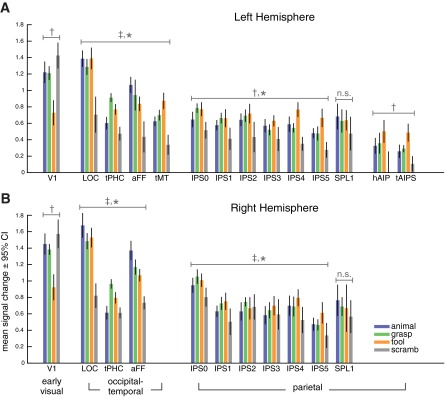Fig. 4.

Mean signal change separated by stimulus category for each functionally defined ROI in the left (A) and right hemispheres (B). Tools evoked a stronger blood oxygen level-dependent (BOLD) response than graspable (non-tool) objects or animals in topographic regions of the IPS, with more consistent differences in the left hemisphere. A similar pattern was observed in the functionally defined regions hPGR and tAIPS in the left hemisphere. In occipital-temporal cortex, functionally defined ROIs showed response patterns consistent with their definitions from the tool-animal localizer. Tools evoked the lowest response in primary visual cortex, indicating that differences in higher order areas were not simply propagated from early visual cortex. No significant differences across intact stimulus categories were observed for superior parietal lobe (SPL1). †P < 0.001, significant main effect across the 3 intact stimulus categories (S). ‡P < 0.001, significant main effect across ROIs (R). *P < 0.001, significant interaction between stimulus category and ROI (R×S). aFF, animal-specific region near the fusiform gyrus; tMT, tool-specific region in the left middle temporal gyrus; tPHC, tool-specific region near the parahippocampal cortex; n.s., not significantly different.
